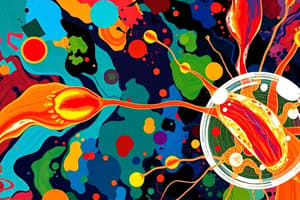Podcast
Questions and Answers
What is the result of polyspermy in sea urchins?
What is the result of polyspermy in sea urchins?
- Normal cellular division
- Formation of a diploid zygote
- Production of more than one egg
- Formation of a triploid nucleus (correct)
Which of the following is a mechanism used by sea urchin eggs to prevent polyspermy?
Which of the following is a mechanism used by sea urchin eggs to prevent polyspermy?
- Production of additional sperm
- Chemical inhibition of sperm motion
- Electric change in the egg plasma membrane (correct)
- Increase in egg size
What occurs during the fast block to polyspermy?
What occurs during the fast block to polyspermy?
- Cortical granules fuse with the plasma membrane
- The sperm membrane ruptures
- Egg cytoplasm expands rapidly
- The electric potential of the egg plasma membrane changes (correct)
What happens to the chromosomes during polyspermy?
What happens to the chromosomes during polyspermy?
Why is the concentration difference of Na+ and K+ ions significant for the fast block to polyspermy?
Why is the concentration difference of Na+ and K+ ions significant for the fast block to polyspermy?
How many poles are formed during the division of triploid chromosomes resulting from polyspermy?
How many poles are formed during the division of triploid chromosomes resulting from polyspermy?
What is the primary role of the plasma membrane during fertilization?
What is the primary role of the plasma membrane during fertilization?
What causes the membrane potential of the sea urchin egg to change from -70 mV to +20 mV during fertilization?
What causes the membrane potential of the sea urchin egg to change from -70 mV to +20 mV during fertilization?
What kind of nucleus is formed when two sperms fertilize an egg in sea urchins?
What kind of nucleus is formed when two sperms fertilize an egg in sea urchins?
What is the primary consequence of unequal chromosome distribution in cells resulting from polyspermy?
What is the primary consequence of unequal chromosome distribution in cells resulting from polyspermy?
What initiates the slow block to polyspermy in sea urchins?
What initiates the slow block to polyspermy in sea urchins?
What happens to a sea urchin egg's membrane potential during the fast block to polyspermy?
What happens to a sea urchin egg's membrane potential during the fast block to polyspermy?
How long does the fast block to polyspermy last after sperm binding?
How long does the fast block to polyspermy last after sperm binding?
Which of the following best describes a method that can prevent polyspermy?
Which of the following best describes a method that can prevent polyspermy?
What is the essential function of the cortical granule reaction?
What is the essential function of the cortical granule reaction?
What happens to the likelihood of polyspermy if sodium ion concentration is insufficient during fertilization?
What happens to the likelihood of polyspermy if sodium ion concentration is insufficient during fertilization?
What function do proteases serve during the slow block to polyspermy?
What function do proteases serve during the slow block to polyspermy?
What is the role of mucopolysaccharides during the slow block to polyspermy?
What is the role of mucopolysaccharides during the slow block to polyspermy?
What is the end result of peroxidase activity during the slow block to polyspermy?
What is the end result of peroxidase activity during the slow block to polyspermy?
What happens to the zona pellucida sperm receptors during the slow block to polyspermy in mammals?
What happens to the zona pellucida sperm receptors during the slow block to polyspermy in mammals?
What is the primary purpose of the slow block to polyspermy?
What is the primary purpose of the slow block to polyspermy?
What structural change occurs due to mucopolysaccharides during fertilization?
What structural change occurs due to mucopolysaccharides during fertilization?
What initiates the process of the slow block to polyspermy in sea urchins?
What initiates the process of the slow block to polyspermy in sea urchins?
Which enzyme contained in mouse eggs cleaves N-acetylglucosamine from ZP3?
Which enzyme contained in mouse eggs cleaves N-acetylglucosamine from ZP3?
Flashcards are hidden until you start studying
Study Notes
Prevention of Polyspermy
- Polyspermy is the fertilization of an egg by multiple sperm.
- In normal monospermy, a haploid sperm nucleus combines with a haploid egg nucleus to form a diploid zygote.
- Polyspermy leads to abnormal development due to an unequal distribution of chromosomes.
Consequences of Polyspermy
- In sea urchins, two sperm result in a triploid nucleus.
- The centrioles of multiple sperm form multiple mitotic spindles, leading to abnormal cell division.
Block to Polyspermy
- The fast block to polyspermy involves a rapid change in the egg's membrane potential.
- The slow block to polyspermy involves the release of cortical granules from the egg.
Fast Block to Polyspermy
- The resting membrane potential of the egg is approximately -70 mV.
- The fast block involves a shift to +20 mV due to sodium ion influx.
- This change in membrane potential prevents further sperm from fusing with the egg.
- Confirmatory experiments show that artificially maintaining a negative membrane potential can induce polyspermy.
Slow Block to Polyspermy in Sea Urchin
- Cortical granules release enzymes that modify the vitelline envelope.
- These enzymes include proteases, mucopolysaccharides, peroxidase, and hyaline.
- Proteases dissolve the protein connecting the vitelline envelope to the cell membrane, removing sperm binding receptors.
- Mucopolysaccharides create an osmotic gradient, causing water to rush into the space between the plasma membrane and the vitelline envelope, leading to expansion.
- Peroxidase hardens the fertilization envelope by cross-linking proteins.
- Hyaline forms a coating around the egg, providing support for blastomeres during cleavage.
Slow Block to Polyspermy in Mammals
- In mammals, the cortical granule reaction modifies the zona pellucida, preventing further sperm binding.
- Cortical granules release enzymes that modify ZP2 and ZP3.
- The enzymes include N-acetylglucosaminidase, which cleaves N-acetylglucosamine from ZP3 carbohydrate chains.
- Proteases also clip ZP2, preventing its binding with sperm.
Studying That Suits You
Use AI to generate personalized quizzes and flashcards to suit your learning preferences.



